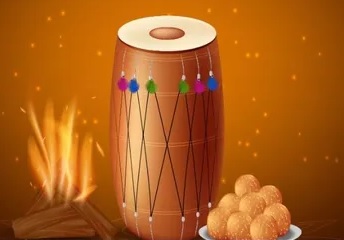Lohri is a popular Punjabi festival that is celebrated in the month of January, marking the end of winter and the beginning of the harvest season. The festival is celebrated by lighting a bonfire, singing and dancing around it, and distributing sweets and savory treats among family and friends. Lohri celebrations are held at a high level of enthusiasm and with great pomp and show in homes where marriages have taken place recently or children have been born. Most North Indians usually celebrate Lohri privately in their homes. Lohri rituals are performed, accompanied by special Lohri songs.The traditional foods that are associated with Lohri are a reflection of the rich and diverse Punjabi cuisine. In this guide, we will take a look at some of the most popular traditional Punjabi foods that are enjoyed during the Lohri celebrations, and how to incorporate them in your diet.
Sarson ka saag and makki ki roti: This is a traditional Punjabi dish made with mustard greens and cornmeal flatbread. It is a staple food during Lohri and is often served with butter and jaggery. The dish is not only delicious but also nutritious. Mustard greens are an excellent source of vitamins A, C, K, and E, as well as minerals such as calcium, potassium, and iron. Makki ki roti, made from cornmeal, is also a good source of carbohydrates and dietary fiber. To make this dish healthier, use less butter and jaggery, and opt for a low-fat yogurt or buttermilk as a side.
Rewdi: This is a sweet made from jaggery and sesame seeds, which is a popular Lohri delicacy. Sesame seeds are rich in minerals such as copper, manganese, and calcium, as well as vitamins B1 and E. Jaggery, made from unrefined cane sugar, is a healthier alternative to refined sugar as it contains minerals such as iron and zinc. However, it’s still a high-calorie sweet, so it’s best to consume it in moderation.
Popcorn and peanuts: These are commonly distributed as prasad (offerings) during Lohri, as they symbolize the start of the harvest season and abundance. Popcorn is a low-calorie and low-fat snack that is a good source of dietary fiber. Peanuts, on the other hand, are a good source of healthy fats, protein, and antioxidants. Both popcorn and peanuts can be enjoyed as a snack, but it’s best to opt for plain or lightly salted varieties to avoid excess sodium intake.
Dahi Bhalla: This is a popular north Indian dish made from lentil dumplings soaked in sweet and tangy yogurt. It is often served as a snack during the festival. Dahi Bhalla is a good source of protein and probiotics, but it can also be high in fat and calories. To make it healthier, use low-fat yogurt and opt for a smaller portion size.
Kheer: This is a sweet pudding made from rice, milk, and sugar, and is a traditional dessert served during the festival. Kheer is a good source of carbohydrates, but it can also be high in calories and sugar. To make it healthier, use low-fat milk and reduce the amount of sugar used.
Incorporating traditional Punjabi foods in your diet during Lohri celebrations can be a delicious and nutritious way to enjoy the festival. However, it’s important to keep in mind that moderation is key and to be mindful of portion sizes and ingredients used. It’s also always good to consult a registered dietitian for your specific nutritional needs and any medical condition you might have. Overall, Lohri is a time to celebrate with friends and family, and traditional Punjabi foods can add to the joy and celebration of the festival.
